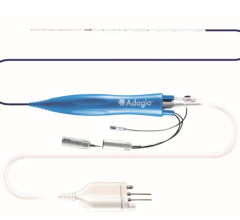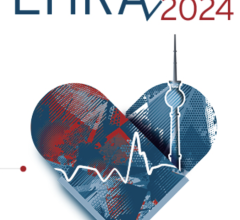
August 29, 2022 — Detailed results from the DELIVER Phase III trial showed AstraZeneca’s FARXIGA (dapagliflozin) significantly reduced the composite of cardiovascular (CV) death or worsening heart failure (HF) in patients with HF and mildly reduced or preserved ejection fraction (EF), compared to placebo. The results were presented today at the European Society of Cardiology Congress 2022 in Barcelona, Spain, and simultaneously published in The New England Journal of Medicine.1
FARXIGA reduced the composite outcome of CV death or worsening of HF by 18% (p<0.001, 16.4% in the dapagliflozin group and 19.5% (absolute risk reduction [ARR] 3.1%) in the placebo group over a median follow-up of 2.3 years). All individual components contributed to the superiority of the primary endpoint. The findings were consistent across key subgroups examined and extend the benefits of FARXIGA to the full spectrum of patients with HF irrespective of left ventricular ejection fraction (LVEF) status. The trial results also showed a symptom benefit in patient-reported outcomes measured by the Kansas City Cardiomyopathy Questionnaire (KCCQ) total symptom score.1
Dr. Scott Solomon, Professor of Medicine at Harvard Medical School and Brigham and Women’s Hospital and Principal Investigator of the DELIVER Phase III trial, said: “These results from DELIVER are important for patients and clinical care as it shows that dapagliflozin is effective regardless of ejection fraction and therefore can be used as foundational therapy in all eligible patients with heart failure. Earlier heart failure with preserved ejection fraction trials have shown attenuation in the highest left ventricular ejection fraction but with dapagliflozin results are consistent across the ejection fraction range. The findings also reinforce most recent treatment guidelines, recommending earlier initiation of guideline-directed medical treatment and may support broader use of SGLT2 inhibitors in clinical practice.”
The updated 2022 joint HF guidelines issued by the American College of Cardiology, the American Heart Association and the Heart Failure Society of America, now recommend sodium-glucose cotransporter 2 (SGLT2) inhibitors such as FARXIGA for HF with mildly reduced EF (HFmrEF) and HF with preserved EF (HFpEF). This expands upon previous recommendations supporting the use of SGLT2 inhibitors in HF with reduced EF (HFrEF).2
Mene Pangalos, Executive Vice President, BioPharmaceuticals R&D, AstraZeneca, said:
“Heart failure patients with left ventricular ejection fraction greater than 40% are the most difficult to treat with few treatment options available to them. We are proud to share the groundbreaking DELIVER results, which have expanded our understanding of the complexities of HF. These data build upon our previous studies demonstrating cardiorenal protection of FARXIGA across patients with type 2 diabetes, chronic kidney disease and heart failure.”
DELIVER was designed with broader inclusion criteria than prior trials in this patient population to also include patients who were hospitalized, recently hospitalized, or those with HF with improved LVEF, for whom evidence-based therapy is limited.1,2 These findings build upon the previously reported results from DAPA-HF, the only SGLT2 inhibitor outcomes trial in HF to demonstrate a significant reduction in mortality, to provide further evidence to support the use of FARXIGA as foundational therapy for patients with HF, regardless of EF.
The safety and tolerability profile of FARXIGA in the DELIVER Phase III trial was consistent with the well-established safety profile of the medicine.
INDICATIONS AND LIMITATIONS OF USE for FARXIGA (dapagliflozin)
FARXIGA is indicated:
- as an adjunct to diet and exercise to improve glycemic control in adults with type 2 diabetes mellitus
- to reduce the risk of hospitalization for heart failure in adults with type 2 diabetes mellitus and either established cardiovascular (CV) disease or multiple CV risk factors
- to reduce the risk of cardiovascular death and hospitalization for heart failure in adults with heart failure (NYHA class II-IV) with reduced ejection fraction
- to reduce the risk of sustained eGFR decline, end‑stage kidney disease, cardiovascular death, and hospitalization for heart failure in adults with chronic kidney disease at risk of progression
FARXIGA is not recommended for patients with type 1 diabetes mellitus. It may increase the risk of diabetic ketoacidosis in these patients.
FARXIGA is not recommended for use to improve glycemic control in adults with type 2 diabetes mellitus with an eGFR less than 45 mL/min/1.73 m2. FARXIGA is likely to be ineffective in this setting based upon its mechanism of action.
FARXIGA is not recommended for the treatment of chronic kidney disease in patients with polycystic kidney disease or patients requiring or with a recent history of immunosuppressive therapy for kidney disease. FARXIGA is not expected to be effective in these populations.
DOSING
To improve glycemic control, the recommended starting dose is 5 mg orally once daily. Dose can be increased to 10 mg orally once daily for additional glycemic control.
For all other indications, the recommended dose is 10 mg orally once daily.
IMPORTANT SAFETY INFORMATION for FARXIGA (dapagliflozin) 5 mg and 10 mg tablets
Contraindications
- Prior serious hypersensitivity reaction to FARXIGA
- Patients on dialysis
Warnings and Precautions
- Ketoacidosis in Diabetes Mellitus has been reported in patients with type 1 and type 2 diabetes receiving FARXIGA. In placebo-controlled trials of patients with type 1 diabetes, the risk of ketoacidosis was increased in patients who received SGLT2 inhibitors compared to patients who received placebo. Some cases were fatal. Assess patients who present with signs and symptoms of metabolic acidosis for ketoacidosis, regardless of blood glucose level. If suspected, discontinue FARXIGA, evaluate and treat promptly. Before initiating FARXIGA, consider risk factors for ketoacidosis. Patients on FARXIGA may require monitoring and temporary discontinuation in situations known to predispose to ketoacidosis
- Volume Depletion: FARXIGA can cause intravascular volume depletion which may manifest as symptomatic hypotension or acute transient changes in creatinine. Acute kidney injury requiring hospitalization and dialysis has been reported in patients with type 2 diabetes receiving SGLT2 inhibitors, including FARXIGA. Patients with impaired renal function (eGFR less than 60 mL/min/1.73 m2), elderly patients, or patients on loop diuretics may be at increased risk for volume depletion or hypotension. Before initiating FARXIGA in these patients, assess volume status and renal function. After initiating therapy, monitor for signs and symptoms of hypotension and renal function
- Urosepsis and Pyelonephritis: SGLT2 inhibitors increase the risk for urinary tract infections (UTIs) and serious UTIs have been reported with FARXIGA. Evaluate for signs and symptoms of UTIs and treat promptly
- Hypoglycemia: FARXIGA can increase the risk of hypoglycemia when coadministered with insulin and insulin secretagogues. Consider lowering the dose of these agents when coadministered with FARXIGA
- Necrotizing Fasciitis of the Perineum (Fournier’s Gangrene): Rare but serious, life-threatening cases have been reported in patients with diabetes mellitus receiving SGLT2 inhibitors including FARXIGA. Cases have been reported in females and males. Serious outcomes have included hospitalization, surgeries, and death. Assess patients presenting with pain or tenderness, erythema, swelling in the genital or perineal area, along with fever or malaise. If suspected, institute prompt treatment and discontinue FARXIGA
- Genital Mycotic Infections: FARXIGA increases the risk of genital mycotic infections, particularly in patients with prior genital mycotic infections. Monitor and treat appropriately
Adverse Reactions
In a pool of 12 placebo-controlled studies, the most common adverse reactions (≥5%) associated with FARXIGA 5 mg, 10 mg, and placebo respectively were female genital mycotic infections (8.4% vs 6.9% vs 1.5%), nasopharyngitis (6.6% vs 6.3% vs 6.2%), and urinary tract infections (5.7% vs 4.3% vs 3.7%).
Use in Specific Populations
- Pregnancy: Advise females of potential risk to a fetus especially during the second and third trimesters
- Lactation: FARXIGA is not recommended when breastfeeding
Please see link to US Full Prescribing Information for FARXIGA.
Notes
HF
HF is a chronic, long-term condition that worsens over time.3 It affects nearly 64 million people globally and is associated with substantial morbidity and mortality.4,5 Chronic HF is the leading cause of hospitalization for those over the age of 65 and represents a significant clinical and economic burden.6 There are several types of HF often defined by LVEF, a measurement of the percentage of blood leaving the heart each time it contracts, including: HFrEF (LVEF less than or equal to 40%), HFmrEF (LVEF 41-49%) and HFpEF (LVEF greater than or equal to 50%).2 Approximately half of all HF patients have HFmrEF or HFpEF, with few therapeutic options available.2,7
DELIVER
DELIVER was an international, randomized, double-blind, parallel-group, placebo-controlled, event-driven Phase III trial designed to evaluate the efficacy of FARXIGA, compared with placebo, in the treatment of HF patients with LVEF greater than 40%, with or without type 2 diabetes (T2D). FARXIGA was given once daily in addition to background therapy (regional standard of care [SoC] for all comorbidities, including diabetes and hypertension, with the exception of concomitant use of a sodium-glucose cotransporter 2 (SGLT2) inhibitor).8 DELIVER is the largest clinical trial to date in HF patients with LVEF above 40%, with 6,263 randomized patients.8,9
The primary endpoint was the time to first occurrence of CV death, hospitalization for HF (hHF) or an urgent HF visit. The secondary endpoint includes the total number of HF events (hHF or urgent HF visit) and CV death, change from baseline in the total symptom score of the KCCQ at eight months, time to the occurrence of CV death and time to the occurrence of death from any cause.8
For more information: www.astrazeneca.com
More news from the European Society of Cardiology (ESC) 2022
References
Solomon S, et al. Dapagliflozin in Heart Failure with Mildly Reduced or Preserved Ejection Fraction. N Engl J Med 2022
Heidenreich PA, et al. 2022 AHA/ACC/HFSA Guideline for the Management of Heart Failure: A report of the American College of Cardiology/American Heart Association Joint Committee on Clinical Practice Guidelines. J Am Coll Cardiol. 2022;79(17):e263-421.
Cleveland Clinic [Internet]. Heart failure; [cited 2022 Jul 26] Available from: https://my.clevelandclinic.org/health/diseases/17069-heart-failure-understanding-heart-failure
Vos T, et al. Global, regional, and national incidence, prevalence, and years lived with disability for 328 diseases and injuries for 195 countries, 1990–2016: A systematic analysis for the Global Burden of Disease Study 2016. Lancet 2017; 390(10100):1211–59.
Mozaffarian D, et al. Heart disease and stroke statistics—2016 update. Circulation. 2016; 133(4):e38–360.
Azad N, et al. Management of chronic heart failure in the older population. J Geriatr Cardiol. 2014; 11(4):329–37.
Dunlay SM, et al. Epidemiology of heart failure with preserved ejection fraction. Nat Rev Cardiol 2017;14(10):591–602.
Solomon SD, et al. Dapagliflozin in heart failure with preserved and mildly reduced ejection fraction: rationale and design of the DELIVER trial. Eur J Heart Fail 2021; 23(7):1217–25.
Clinicaltrials.gov [Internet]. Dapagliflozin Evaluation to Improve the LIVEs of Patients With Preserved Ejection Fraction Heart Failure; [cited 2022 Jul 26]. Available from: https://clinicaltrials.gov/ct2/show/NCT03619213.


 April 10, 2024
April 10, 2024 








